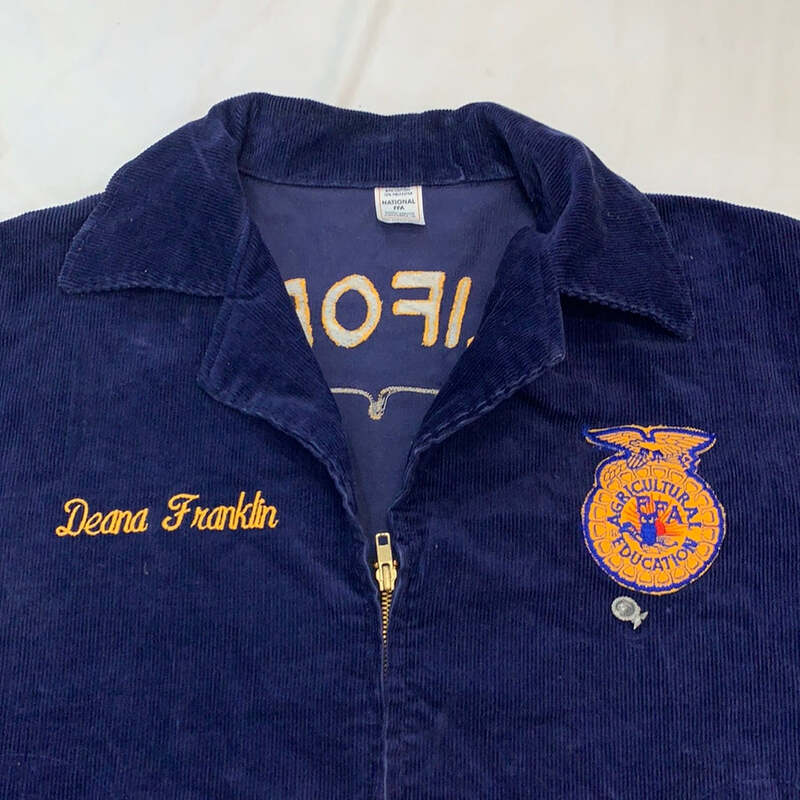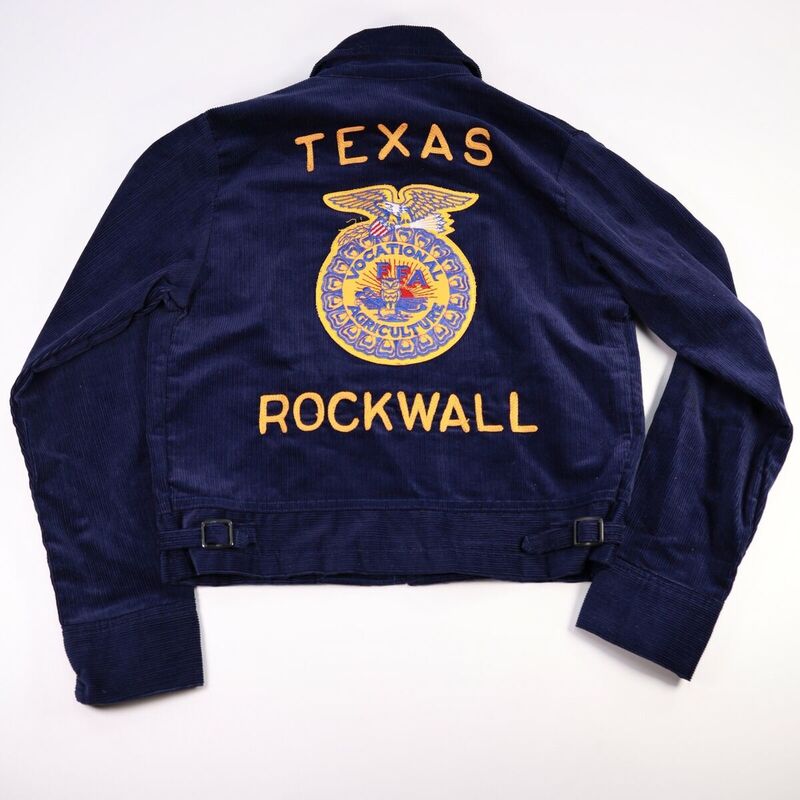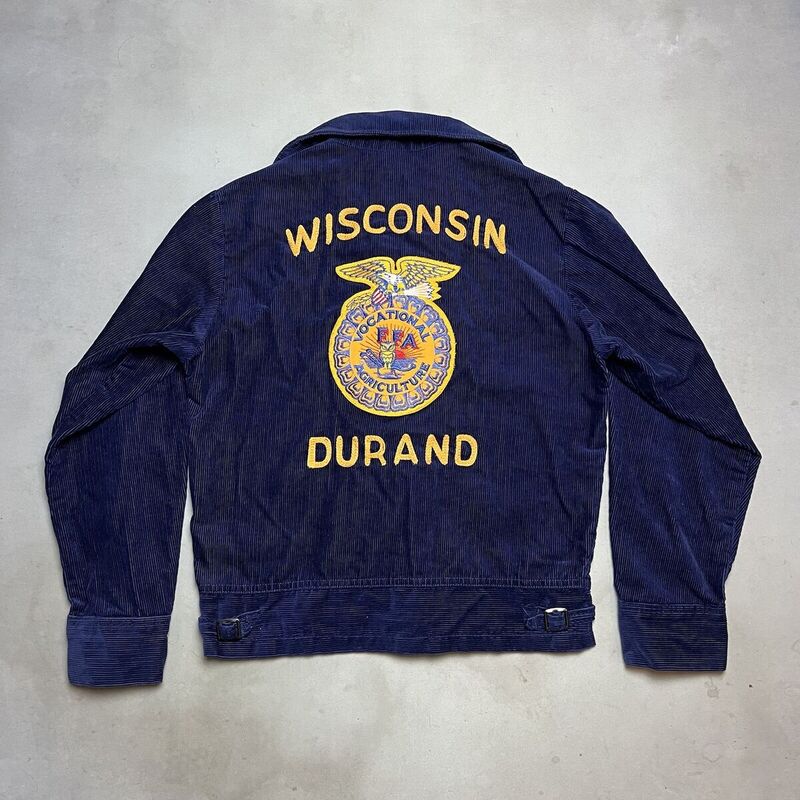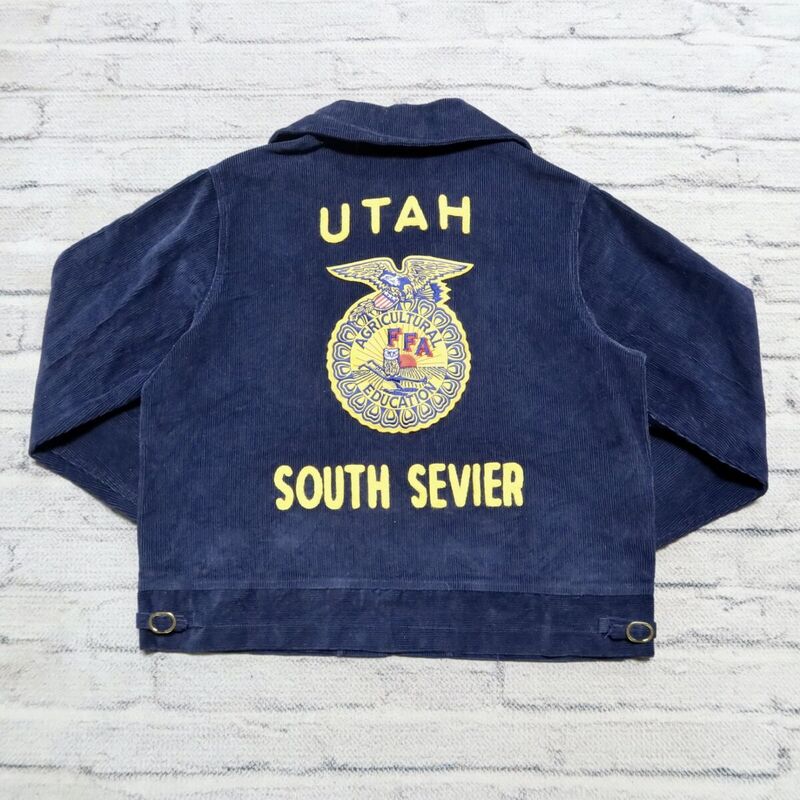
The Birth of the FFA Jacket
Originating in a small town in Ohio, the FFA jacket holds a story as robust as its corduroy fabric. It wasn’t merely a piece of apparel; it emerged as a symbol of belonging and pride among agricultural students. The journey from a simple blue corduroy jacket to an emblem of the National FFA Organization is a testament to the jacket’s enduring legacy.
Iconic Blue Corduroy Origins
In 1933, the sight of a blue corduroy jacket in a local store window sparked inspiration for Gus Lintner, an FFA advisor. He envisioned a garment that was practical for farm work and yet distinguished FFA members. From this vision, the sturdy, blue corduroy jacket became a pivotal part of the FFA uniform, blending functionality with symbolism.
Adoption by the National FFA Organization
The jacket’s popularity quickly spread, reaching a pivotal moment at the National FFA Convention where it was officially adopted. With its distinctive blue color, the FFA jacket united members across the nation. The adoption of this jacket marked the beginning of a tradition that would proliferate throughout the FFA’s history, creating a unique identity for its members.
Significance of the Blue Jacket
The blue FFA jacket is more than just an article of clothing.
Symbolism and Tradition
Each stitch of the FFA jacket weaves a rich tradition of agricultural pride.
It represents values like leadership, personal growth, and career success.
Worn at events, it signals a commitment to FFA’s noble mission.
Unity and Identity for FFA Members
The jacket bonds members together, symbolizing a shared identity.
Across meetings and competitions, it fosters a sense of community.
Wearing it, members represent not just themselves, but FFA’s collective spirit.
Jacket Design and Features
The FFA jacket’s timeless design serves both function and form. Every aspect, from the lettering to the materials, reflects the organization’s attention to detail and commitment to quality.
Official FFA Jacket Lettering and Embroidery
With precision, the FFA jackets showcase the pride of the members. The official jacket features computerized embroidery on the front, displaying the wearer’s full name and one chapter title. The Curtis Script font, in official corn gold color, Pantone 116C, lends the clothing its iconic look. This embroidery upholds the jacket’s professional and polished appearance.
Material and Construction Quality
Crafted from 100 percent domestic cotton, the FFA jacket embraces durability and comfort in its blue corduroy fabric. The quality of materials ensures the jacket stands up to the rigorous use by active FFA members, whether in the field or at official events. With a concealed zipper and slash welt pockets, the design is both practical and stylish. Additionally, adjustable features allow for a fit that honors the wearer’s commitment to the organization.
Who Can Wear an FFA Jacket?
Policies for Active and Past Members
FFA jackets represent a legacy and honor within the organization. According to official policy, only currently registered FFA members may purchase and wear new FFA jackets. This policy underscores the jacket as a symbol of active involvement in the community and dedication to FFA principles. Past members, who have cherished memories from their time with FFA, may seek keepsakes but can’t order new jackets. They may, however, hold onto their original jackets as mementos of their FFA journey.
Although strict, these rules reflect the high regard for the FFA jacket as a representation of membership and position within the organization. It’s important for buyers to accurately measure for size so their jacket fits well, since the personalized nature of the garment does not allow for returns or refunds.
The Inclusivity Evolution within FFA
The FFA’s policy on who can wear its jacket has evolved to reflect the organization’s growing inclusivity. Women and individuals from diverse backgrounds now proudly wear the FFA jacket, showcasing the organization’s commitment to embrace a broader agricultural community. This was not always the case, as the inclusivity journey spanned from exclusive beginnings to the welcoming organization it is today.
Originally, demographic restrictions were present, but the changes in bylaws and Constitution over the years have eliminated these barriers. Now, FFA jackets serve as a symbol of unity and equality, celebrating every member’s contribution to the field, irrespective of their gender or race. Understanding the roots of these transitions highlights FFA’s progress towards an inclusive culture where all members can feel proud to don the FFA jacket.
The Give the Gift of Blue Program
The FFA’s Give the Gift of Blue program embodies the organization’s commitment to supporting members who may face financial barriers. With the iconic FFA jacket carrying significant cost, this program ensures that deserving students can also embrace the FFA legacy. Donations from generous individuals and corporate partners contribute to the program’s success, allowing members in need to receive their own blue jacket.
Donors and Impact on FFA Membership
Every donation to the Give the Gift of Blue program sparks a positive impact on FFA’s future. Individual donors and organizations like Corteva Agriscience have played a pivotal role in this initiative. Thanks to their support, the program has successfully clothed thousands of members in the symbolic blue jackets, reinforcing the sense of community and belonging within the FFA.
How the Program Supports Members in Need
This program operates on the profound belief that all members should have the opportunity to wear the FFA jacket with pride. An $85 gift covers the cost of a jacket and official tie or scarf, while any donation amount contributes towards the overarching goal. When members don the blue corduroy, they are reminded of their vital place within the larger FFA community and the agricultural industry.
Jacket Care and Personalization Rules
Caring for an FFA jacket requires attention to detail to maintain its iconic look. Here are tips for keeping your jacket in prime condition.
Non-returnable Personalized Garment
Remember, FFA jackets are custom made and cannot be returned. Measure accurately before ordering to ensure a perfect fit. Any embroidery or customization cements the jacket to the individual, making it uniquely theirs but non-exchangeable. Handle with care, as this garment symbolizes personal achievement and your commitment to FFA values.
Official Dress Code and Pin Placement Guidelines
Adherence to the FFA’s official dress code is crucial when wearing the blue corduroy jacket. Members should zip their jackets to the top and pair them with a white collared shirt or blouse. Male members should wear the official FFA tie, and female members, the official FFA scarf. Black slacks or skirts, black shoes, and black socks or hosiery complete the ensemble. Keep the jacket’s exterior polished by limiting pin decoration to three: the highest degree, highest office, and highest award pins. These pins belong below your name, except for State or American FFA Degree pins, which vary by state. This uniformity is part of the tradition that enhances the FFA legacy and encourages member pride.
FFA?s Legacy and the Jacket?s Place in History
The FFA jacket stands not just as a piece of apparel but as a symbol of the organization’s legacy. Its very fabric tells a story of agricultural education and the evolution of the FFA’s values and principles over time.
Changing Styles Reflecting Organizational Evolution
Through the decades, the FFA jacket has undergone subtle but meaningful changes. These changes are a mirror to the organization’s growth. The transition from buttoned to zippered jackets, the introduction of a woman’s cut post-1969, and the evolution of the back lettering to a standard chain stitch all highlight FFA’s openness to change. This responsiveness ensures that while the style adapts, the tradition endures, and all members—no matter their background—feel included in this remarkable family.
Impactful Stories and Milestones
Every blue corduroy jacket carries with it stories of personal triumph, community service, and a commitment to the future of agriculture. Milestones like the first FFA jacket in 1933, the integration of women, and the inclusion of minority groups speak volumes of the organization’s dedication to growth and diversity. Special programs, like the donation of over 18,000 jackets to members in need, showcase the profound impact FFA and its community have on nurturing the next generation of agricultural leaders. With every sleeve rolled up and every zipper pulled, FFA jackets continue to clothe the pioneers of tomorrow’s agribusiness, echoing the legacy of generations past and fostering hope for generations to come.



